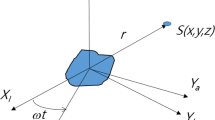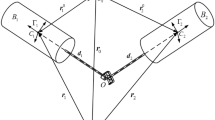Abstract
The gravitationally coupled orbit–attitude dynamics, also called the full dynamics, in which the spacecraft is modeled as a rigid body, is a high-precision model for the motion in the close proximity of an asteroid. A feedback control law is proposed to stabilize relative equilibria of the coupled orbit–attitude motion in a uniformly rotating second degree and order gravity field by utilizing the Hamiltonian structure. The feedback control law is consisted of potential shaping and energy dissipation. The potential shaping makes the relative equilibrium a minimum of the modified Hamiltonian by modifying the potential artificially. With the energy-Casimir method, it is theoretically proved that an unstable relative equilibrium can always be stabilized in the Lyapunov sense by the potential shaping with sufficiently large feedback gains. Then, the energy dissipation leads the motion to converge to the relative equilibrium. The proposed stabilization control law has a simple form and is easy to implement autonomously, which can be attributed to the utilization of natural dynamical behaviors in the controller design.
Similar content being viewed by others
Change history
11 February 2022
A Correction to this paper has been published: https://doi.org/10.1007/s42064-022-0136-2
References
Scheeres, D. J. Spacecraft at small NEO. 2006. arXiv:physics/0608158.
Wang, Y., Xu, S. Gravitational orbit-rotation coupling of a rigid satellite around a spheroid planet. Journal of Aerospace Engineering, 2014, 27(1): 140–150.
Scheeres, D. J. Orbit mechanics about asteroids and comets. Journal of Guidance, Control, and Dynamics, 2012, 35(3): 987–997.
Scheeres, D. J. Orbit mechanics about small bodies. Acta Astronautica, 2012, 72: 1–14.
Hu, W. Orbital motion in uniformly rotating second degree and order gravity fields. Ph.D. Dissertation. The University of Michigan, 2002.
San-Juan, J. F., Abad, A., Scheeres, D. J., Lara, M. A first order analytical solution for spacecraft motion about (433) Eros. In: Proceedings of the AIAA/AAS Astrodynamics Specialist Conference and Exhibit, Guidance, Navigation, and Control and Colocated Conferences, 2002: AIAA 2002-4543.
Hirabayashi, M., Morimoto, M. Y., Yano, H., Kawaguchi, J., Bellerose, J. Linear stability of collinear equilibrium points around an asteroid as a two-connected-mass: Application to fast rotating Asteroid 2000EB14. Icarus, 2010, 206(2): 780–782.
Liu, X., Baoyin, H., Ma, X. Equilibria, periodic orbits around equilibria, and heteroclinic connections in the gravity field of a rotating homogeneous cube. Astrophysics and Space Science, 2011, 333: 409–418.
Yu, Y., Baoyin, H. Resonant orbits in the vicinity of asteroid 216 Kleopatra. Astrophysics and Space Science, 2013, 343(1): 75–82.
Li, X., Qiao, D., Cui, P. The equilibria and periodic orbits around a dumbbell-shaped body. Astrophysics and Space Science, 2013, 348(2): 417–426.
Jiang, Y., Baoyin, H., Li, J., Li, H. Orbits and manifolds near the equilibrium points around a rotating asteroid. Astrophysics and Space Science, 2014, 349(1): 83–106.
Riverin, J.-L., Misra, A. K. Attitude dynamics of satellites orbiting small bodies. In: Proceedings of the AIAA/AAS Astrodynamics Specialist Conference and Exhibit, Guidance, Navigation, and Control and Colocated Conferences, 2002: AIAA 2002-4520.
Misra, A. K., Panchenko, Y. Attitude dynamics of satellites orbiting an asteroid. The Journal of the Astronautical Sciences, 2006, 54(3–4): 369–381.
Kumar, K. D. Attitude dynamics and control of satellites orbiting rotating asteroids. Acta Mechanica, 2008, 198(1–2): 99–118.
Wang, Y., Xu, S. Attitude stability of a spacecraft on a stationary orbit around an asteroid subjected to gravity gradient torque. Celestial Mechanics and Dynamical Astronomy, 2013, 115(4): 333–352.
Wang, Y., Xu, S. Equilibrium attitude and nonlinear stability of a spacecraft on a stationary orbit around an asteroid. Advances in Space Research, 2013, 52(8): 1497–1510.
Wang, L.-S., Krishnaprasad, P. S., Maddocks, J. H. Hamiltonian dynamics of a rigid body in a central gravitational field. Celestial Mechanics and Dynamical Astronomy, 1990, 50(4): 349–386.
Wang, L.-S., Maddocks, J. H., Krishnaprasad, P. S. Steady rigid-body motions in a central gravitational field. Journal of the Astronautical Sciences, 1992, 40(4): 449–478.
Teixidó Roman, M. Hamiltonian methods in stability and bifurcations problems for artificial satellite dynamics. Master Thesis. Universitat Politècnica de Catalunya, 2010: 51–72.
Wang, Y., Xu, S. Symmetry, reduction and relative equilibria of a rigid body in the J2 problem. Advances in Space Research, 2013, 51(7): 1096–1109.
Wang, Y., Xu, S. Stability of the classical type of relative equilibria of a rigid body in the J2 problem. Astrophysics and Space Science, 2013, 346(2): 443–461.
Wang, Y., Xu, S., Zhu, M. Stability of relative equilibria of the full spacecraft dynamics around an asteroid with orbit–attitude coupling. Advances in Space Research, 2014, 53(7): 1092–1107.
Wang, Y., Xu, S. On the nonlinear stability of relative equilibria of the full spacecraft dynamics around an asteroid. Nonlinear Dynamics, 2014, 78(1): 1–13.
Lee, D., Sanyal, A. K., Butcher, E. A., Scheeres, D. J. Almost global asymptotic tracking control for spacecraft body-fixed hovering over an asteroid. Aerospace Science and Technology, 2014, 38: 105–115.
Sanyal, A., Izadi, M., Misra, G., Samiei, E., Scheeres, D. J. Estimation of dynamics of space objects from visual feedback during proximity operations. In: Proceedings of the AIAA/AAS Astrodynamics Specialist Conference, AIAA SPACE Forum, 2014: AIAA 2014-4419.
Misra, G., Izadi, M., Sanyal, A., Scheeres, D. J. Coupled orbit–attitude dynamics and relative state estimation of spacecraft near small Solar System bodies. Advances in Space Research, 2016, 57(8): 1747–1761.
Wang, Y., Xu, S. Hamiltonian structures of dynamics of a gyrostat in a gravitational field. Nonlinear Dynamics, 2012, 70(1): 231–247.
Maciejewski, A. J. Reduction, relative equilibria and potential in the two rigid bodies problem. Celestial Mechanics and Dynamical Astronomy, 1995, 63(1): 1–28.
Maciejewski, A. J. A simple model of the rotational motion of a rigid satellite around an oblate planet. Acta Astronomica, 1997, 47: 387–398.
Beck, J. A., Hall, C. D. Relative equilibria of a rigid satellite in a circular Keplerian orbit. Journal of the Astronautical Sciences, 1998, 46(3): 215–247.
Van der Schaft, A. J. Stabilization of Hamiltonian systems. Nonlinear Analysis: Theory, Methods & Applications, 1986, 10(10): 1021–1035.
Jalnapurkar, S. M., Marsden, J. E. Stabilization of relative equilibria II. Regular & Chaotic Dynamics, 1998, 3(3): 161–179.
Bloch, A. M., Leonard, N. E., Marsden, J. E. Potential shaping and the method of controlled Lagrangians. In: Proceedings of the 38th IEEE Conference on Decision and Control, 1999, 2: 1652–1657.
Sanyal, A. K., Shen, J., McClamroch, N. H., Bloch, A. M. Stability and stabilization of relative equilibria of dumbbell bodies in central gravity. Journal of Guidance, Control, and Dynamics, 2005, 28(5): 833–842.
Marsden, J. E., Ratiu, T. S. Introduction to Mechanics and Symmetry: A Basic Exposition of Classical Mechanical Systems. New York: Springer, 1999.
Acknowledgements
This work was supported by the National Natural Science Foundation of China under Grant Nos. 11432001 and 11602009, and the Fundamental Research Funds for the Central Universities.
Author information
Authors and Affiliations
Corresponding author
Additional information
Yue Wang received his B.Eng. and Ph.D. degrees in aerospace engineering from Beihang University (formerly known as Beijing University of Aeronautics and Astronautics), Beijing, China, in 2009 and 2014, respectively. From 2014 to 2015, he worked as a postdoctoral fellow in the Distributed Space Systems Lab in the Faculty of Aerospace Engineering at Technion–Israel Institute of Technology, Haifa, Israel. In 2016, he joined the School of Astronautics at Beihang University as an associate professor of the “Zhuoyue” Recruitment Program. His research interests center on the astrodynamics, orbital dynamics, dynamics and control about asteroids, proximity operations, and space debris mitigation.
Shijie Xu received his B.Eng. degree from the Department of Mechanical Engineering, Northeast Forestry University, Harbin, China, in 1976, M.S. degree from the Laboratory of Flight Dynamics, Harbin Institute of Technology, Harbin, China, in 1983, and Ph.D. degree with a specialization in automatic controls from Henri Poincaré University, Nancy, France, in 1995. From 1989 to 2000, he was with Harbin Institute of Technology, where he was an associate professor and then a professor. In 2000, he joined the School of Astronautics, Beihang University, Beijing, China, where he is currently a professor. He has authored or coauthored over 300 papers in journals and conferences. His research interests include robust control, astrodynamics, spacecraft guidance, navigation and control, and deep space exploration. He was a recipient of the Key Program Funding of the National Natural Science Foundation of China from 2015 to 2019.
Rights and permissions
About this article
Cite this article
Wang, Y., Xu, S. Stabilization of coupled orbit–attitude dynamics about an asteroid utilizing Hamiltonian structure. Astrodyn 2, 53–67 (2018). https://doi.org/10.1007/s42064-017-0013-6
Received:
Accepted:
Published:
Issue Date:
DOI: https://doi.org/10.1007/s42064-017-0013-6




